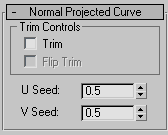![]()
You can use normal projected curves for trimming.

Trimming a surface with a normal projected curve
If the projection intersects the surface in two or more locations, the intersection closest to the seed point is the one that creates the curve.
Procedures
To create a normal projected curve:
- In the NURBS toolbox , turn on
 (Create Normal Projected Curve).
(Create Normal Projected Curve). - Click the curve, then click the surface where you want the normal projected curve to lie.
If the curve can be projected onto the surface in the surface's normal direction, the projected curve is created. The original, parent curve can go "off the edge of the surface." The projected curve is created only where the projection and the surface intersect.
The NURBS object must contain at least one surface and one cruve.
Interface
Normal Projected Curve rollout (creation time)

Trim Controls group
- Trim
-
When on, trims the surface against the curve. When off, the surface isn’t trimmed.
If it's impossible to trim with this curve, the surface is displayed in the error color (orange by default). For example, the curve is unusable for trimming if it neither crosses the edge of the surface nor forms a closed loop.
- Flip Trim
-
When on, trims the surface in the opposite direction.
- U Seed / V Seed
-
Change the UV location of the seed value on the surface. If there is a choice of projections, the projection closest to the seed point is the one used to create the curve.
Normal Projected Curve rollout (modification time)

Trim Controls group
- Trim
-
When on, trims the surface against the curve. When off, the surface isn’t trimmed.
If it's impossible to trim with this curve, the surface is displayed in the error color (orange by default). For example, the curve is unusable for trimming if it neither crosses the edge of the surface nor forms a closed loop.
- Flip Trim
-
When on, trims the surface in the opposite direction.
- U Seed / V Seed
-
Change the UV location of the seed value on the surface. If there is a choice of projections, the projection closest to the seed point is the one used to create the curve.
- Replace Curve / Replace Surface
-
Let you replace the parent sub-objects. Click either button, then click a curve or surface to replace the original parent object.